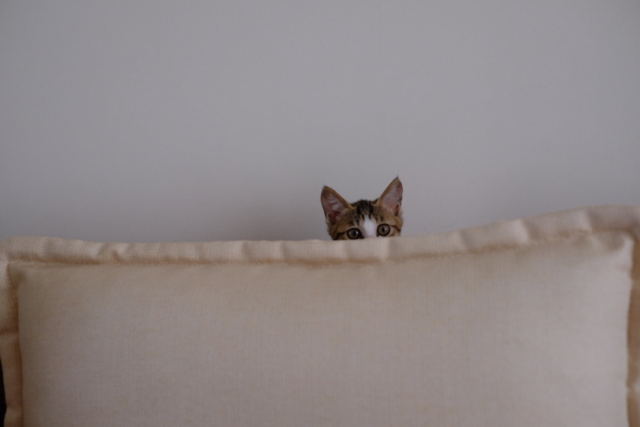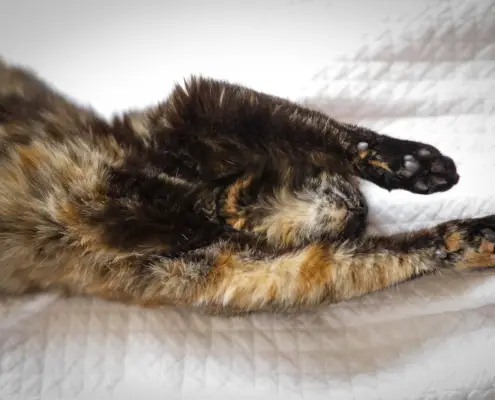
Cats have long been known for their mysterious and enigmatic nature. They are creatures of habit and are known to have a strong instinctual need for hiding. At times, they may seem aloof and unapproachable, but there is much more to their behavior than meets the eye. Why do cats like to hide? What is the significance of this behavior, and how can you decode it? This article delves into the enigmatic world of cats, providing insights into their behavior and offering tips on how to understand and embrace their need for hiding.
The Mysterious Nature of Cats
Cats are independent creatures, and their behavior can often be difficult to decipher. They are known to be aloof and distant, and they often engage in behaviors that are seemingly random or inexplicable. However, cats are also incredibly intelligent animals, and their behavior is often purposeful and intentional.
One of the most enigmatic aspects of cat behavior is their need for hiding. Cats are known to seek out hiding spots, whether it be under a bed, in a closet, or behind a piece of furniture. This behavior is instinctual, and it serves a number of important functions.
The Instinctual Need for Hiding
The instinctual need for hiding is deeply ingrained in cats. In the wild, cats are predators, but they are also prey. As a result, they have evolved to be incredibly stealthy and to hide from potential threats. Hiding allows cats to remain hidden from predators while they hunt for prey, and it also provides them with a safe place to rest and recuperate.
This instinctual need for hiding is still present in domestic cats, even though they are no longer living in the wild. Domestic cats may not face the same threats as their wild counterparts, but they still have a strong instinctual need for hiding. This behavior is not only instinctual but also serves a number of important psychological functions.
Reasons Why Cats Like to Hide
There are a number of reasons why cats like to hide. For one, hiding provides cats with a sense of security and safety. Cats are vulnerable animals, and they need a safe place to retreat to if they feel threatened or anxious. Hiding allows cats to feel secure and protected, which can help to reduce their stress levels and improve their overall well-being.
In addition to providing a sense of security, hiding also allows cats to regulate their environment. Cats are sensitive animals, and they can become overwhelmed by stimuli such as noise, light, and movement. Hiding allows cats to control their environment and to regulate the amount of stimulation that they are exposed to. This can help to reduce their stress levels and improve their overall quality of life.
The Importance of Providing Hiding Spots for Cats
Given the importance of hiding for cats, it is essential that they have access to hiding spots in their environment. Hiding spots can take many forms, from a simple cardboard box to a designated cat cave. The key is to provide a variety of hiding spots throughout your home to give your cat a range of options.
When selecting hiding spots for your cat, it is important to consider their needs and preferences. Cats are individuals, and they may have different preferences when it comes to hiding. Some cats may prefer to hide in enclosed spaces, while others may prefer to hide in more open areas. By providing a variety of hiding spots, you can ensure that your cat has the opportunity to choose the spot that works best for them.
Decoding Cat Behavior Through Hiding
Cats are complex creatures, and their behavior can be difficult to interpret. However, by understanding the importance of hiding and providing the right environment for your cat, you can begin to decode their behavior and gain a better understanding of their needs.
One way to decode cat behavior through hiding is to pay attention to their body language. When a cat is feeling stressed or anxious, they may seek out a hiding spot. If you notice your cat spending more time than usual in their hiding spot, it may be a sign that they are feeling stressed or anxious.
Another way to decode cat behavior through hiding is to observe their behavior when they emerge from their hiding spot. If your cat emerges from their hiding spot feeling relaxed and calm, it may be a sign that they are simply seeking a safe place to rest. However, if your cat emerges from their hiding spot looking tense or agitated, it may be a sign that they are feeling stressed or anxious.
Signs that Your Cat May be Stressed or Anxious
There are a number of signs that your cat may be feeling stressed or anxious. These include:
- Hiding more than usual
- Avoiding interaction with people or other pets
- Increased vocalization
- Changes in appetite or litter box habits
- Aggression or destructive behavior
If you notice any of these signs, it is important to take steps to reduce your cat’s stress levels and to provide them with a safe and comfortable environment.
Techniques to Encourage Your Cat to Come Out of Hiding
If your cat is spending too much time in their hiding spot, there are a number of techniques that you can use to encourage them to come out and explore their environment. One technique is to provide them with interactive toys and puzzles that will keep them engaged and active. Another technique is to create a comfortable and inviting environment that will encourage your cat to explore.
It is also important to be patient and to give your cat time to adjust. Cats are creatures of habit, and they may take some time to become comfortable with their new environment. By providing them with a safe and comfortable space, you can help to reduce their stress levels and encourage them to come out of hiding.
Creating a Safe and Comfortable Environment for Your Cat
Creating a safe and comfortable environment for your cat is essential for their overall well-being. This includes providing them with a variety of hiding spots, as well as access to food, water, and litter boxes. It also means creating a calm and quiet environment that is free from excessive noise and stimulation.
When creating your cat’s environment, it is important to consider their individual needs and preferences. Some cats may prefer a quiet and secluded environment, while others may prefer a more social and interactive environment. By understanding your cat’s needs and preferences, you can create an environment that is tailored to their unique needs.
Understanding Your Cat’s Personal Hiding Preferences
As mentioned earlier, cats are individuals, and they may have different preferences when it comes to hiding. Some cats may prefer to hide in enclosed spaces, while others may prefer to hide in more open areas. By observing your cat’s behavior and paying attention to their body language, you can begin to understand their personal hiding preferences.
Once you understand your cat’s personal hiding preferences, you can provide them with the right environment to meet their needs. This may involve providing them with a variety of hiding spots, as well as creating a safe and comfortable environment that is free from excessive noise and stimulation.
Embracing and Respecting Your Cat’s Need for Hiding
In conclusion, understanding why cats like to hide is essential for providing them with a safe and comfortable environment. By embracing and respecting your cat’s need for hiding, you can help to reduce their stress levels and improve their overall well-being. By providing a variety of hiding spots and paying attention to your cat’s behavior, you can begin to decode their behavior and gain a better understanding of their needs. With patience, love, and respect, you can create a happy and healthy environment for your feline friend.
Give your cat a safe and comfortable environment by providing them with a variety of hiding spots and paying attention to their individual needs and preferences. By embracing and respecting your cat’s need for hiding, you can help to reduce their stress levels and improve their overall well-being.
If you enjoyed my article, I would appreciate you sharing it with your network.

Sima Ndlebe
Sima writes for CatBuzz. He is interested in Cats, Health and Fitness, and Entrepreneurship.
Published: 5 December 2023



